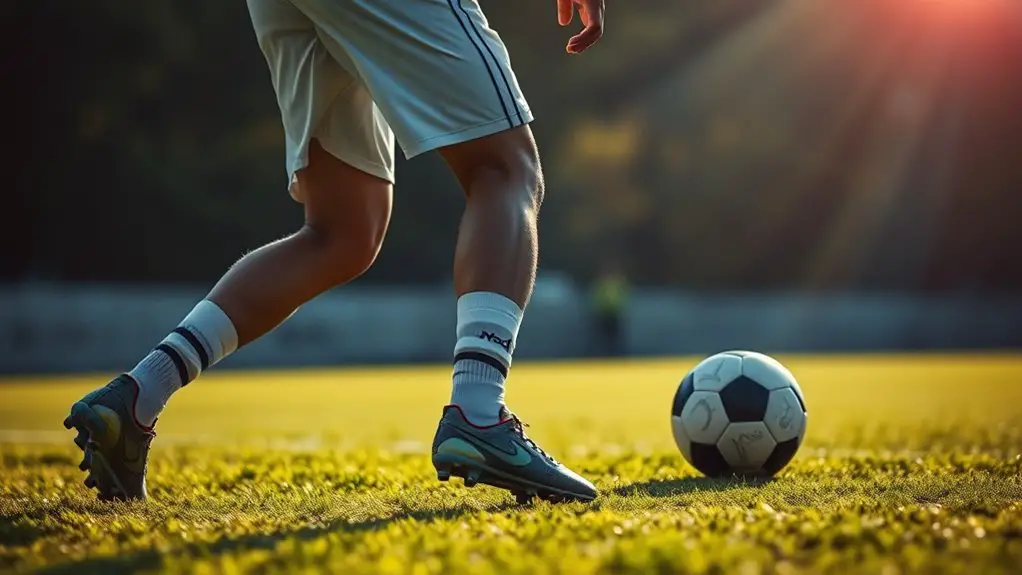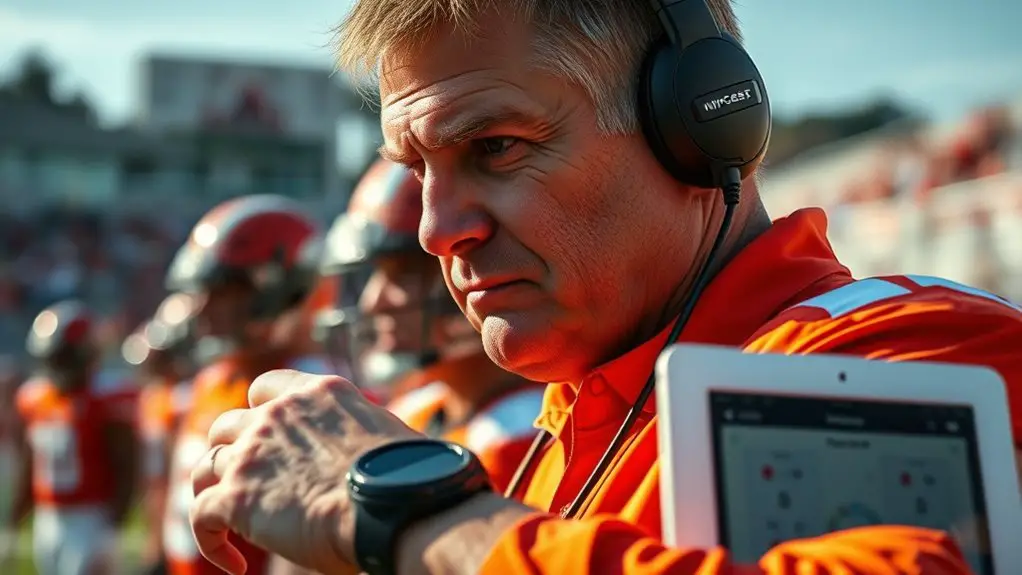To improve your reaction time on defense, focus on key drills like the Tennis Ball Drop and lateral shuffles that boost agility and hand-eye coordination. Enhance mental conditioning through visualization and mindfulness techniques to sharpen your focus. Prioritize nutrition and hydration to keep your body and mind sharp. Don't forget to monitor your progress and set clear goals to track improvement. There are even more strategies you can explore to elevate your defensive skills.
Understanding Reaction Time and Its Importance in Sports
Reaction time is a crucial element that can make or break your performance in sports. Whether you're on the field, court, or track, your ability to respond quickly to opponents or game situations can set you apart. When the game's on the line, every millisecond counts. A sharp reaction time allows you to seize opportunities, dodge threats, and make plays that others might miss. You want to be in control, ready to adapt and react.
Improving your reaction time can enhance your overall sports performance, giving you that edge over competitors. It's not just about physical speed; it's about mental agility too. The quicker you process information, the faster you can act. Embracing drills and techniques designed to sharpen your reflexes will empower you, allowing you to harness your freedom on the field. Incorporating mental conditioning techniques can further sharpen your responsiveness and decision-making under pressure. So, take charge and focus on this essential skill—it could be the key to your success.
Key Factors Affecting Reaction Time
Several factors influence how quickly you can respond in sports, and understanding them can help you improve your reaction time. One key element is your visual perception. The way you process what you see directly impacts how fast you react. The quicker you can interpret visual cues—like an opponent's movements—the faster you'll be able to respond.
Another significant factor is muscle memory. Developing this through consistent practice allows your body to react almost instinctively during high-pressure situations. The more you train specific movements, the less conscious effort you'll need, freeing you up to focus on the game itself.
Additionally, your physical condition matters; fatigue can slow your reactions. By staying fit and regularly practicing drills that enhance both your visual perception and muscle memory, you can cultivate a sharper, faster response time on defense. Embrace these factors, and watch your game elevate! Moreover, incorporating agility drills into your training routine can significantly boost your overall reaction speed.
Essential Drills to Enhance Reflexes
To sharpen your reflexes on defense, incorporating specific drills into your training routine is essential. Start with reaction drills like the "Tennis Ball Drop." Have a partner drop a tennis ball from shoulder height and try to catch it before it hits the ground. This simple exercise sharpens your hand-eye coordination and quickens your response time.
Another great option is lateral shuffle drills. Set up cones and quickly shuffle side to side, focusing on speed and agility. This'll help you react faster to opponents' movements.
You can also try reflex exercises using a reaction ball. Toss it against a wall and catch it as it bounces unpredictably. Additionally, incorporating strength training into your routine enhances muscle power for directional changes.
Incorporating these activities regularly will enhance your reflexes, giving you the edge you need on the defensive end. With focused practice, you'll feel more confident and ready to react in any situation.
Mental Conditioning Techniques for Faster Reactions
While physical drills are essential for enhancing your defensive skills, mental conditioning plays an equally important role in improving your reaction time. To boost your performance, try incorporating visualization techniques. Picture yourself in various defensive scenarios, reacting swiftly and effectively. This mental rehearsal can help you develop muscle memory and confidence.
Focus exercises are another powerful tool. Set aside time to concentrate on specific tasks, blocking out distractions to sharpen your ability to stay present during games. Mindfulness practices, like meditation, can enhance your awareness and focus, allowing you to respond more quickly to sudden changes in the game. Additionally, engaging in stress reduction techniques can promote calmness and clarity, further improving your reaction time under pressure.
Finally, engage in cognitive training, such as reaction time games or puzzles, that challenge your brain and improve processing speed. By blending these mental techniques with your physical training, you'll create a well-rounded approach that elevates your defensive game and boosts your freedom on the field.
Incorporating Agility Training Into Your Routine
To boost your reaction time on defense, incorporating agility training into your routine is key. Start with dynamic warm-up exercises to prepare your body, followed by ladder drills that improve your foot speed and coordination. These targeted workouts can help you stay one step ahead of your opponent. Additionally, focusing on improving overall agility through consistent practice can greatly enhance your performance and decision-making skills on the field.
Dynamic Warm-Up Exercises
A dynamic warm-up is essential for athletes looking to enhance their reaction time on defense, and incorporating agility training into your routine can make a significant difference. Start your session with the right mix of dynamic stretching and mobility exercises to get your body ready to move freely. Here are four effective dynamic warm-up exercises:
- Leg Swings: Swing your legs forward and backward to loosen up your hip joints.
- High Knees: Run in place, bringing your knees up to your chest to engage your core.
- Butt Kicks: While jogging, kick your heels towards your glutes to activate your hamstrings.
- Lateral Shuffles: Move side-to-side quickly to improve lateral movement and agility.
These exercises will boost your performance and reaction time on the field!
Ladder Drills Benefits
Incorporating ladder drills into your agility training routine can take your reaction time on defense to the next level. These ladder drill techniques are designed to enhance your foot speed, coordination, and overall agility, making you a more elusive defender. By practicing consistently, you'll experience the agility ladder benefits, such as improved quickness and the ability to change direction swiftly when it matters most. This newfound freedom of movement allows you to respond faster to your opponent's actions, giving you the edge you need on the field. So, grab an agility ladder, and start weaving through those drills. You'll notice how these simple exercises can transform your defensive game and elevate your performance to new heights.
Nutrition and Recovery for Optimal Performance
While many athletes focus on skill drills and tactical training, nutrition and recovery play essential roles in enhancing your reaction time on defense. To maximize your performance, consider these key strategies:
- Nutrient Timing: Fuel your body with the right nutrients before and after workouts. Carbs and protein can help optimize energy levels and muscle recovery.
- Hydration: Stay hydrated to maintain cognitive function and physical performance. Dehydration can slow your reaction time, so monitor your urine color to assess hydration status.
- Sleep Quality: Prioritize restorative sleep to improve your mental sharpness and overall reaction speed. Aim for 7-9 hours of quality sleep each night.
- Active Recovery: Incorporate light activities like yoga or stretching on rest days. These recovery strategies keep your muscles loose and responsive.
Tracking Progress and Setting Goals
To really improve your reaction time on defense, you need to establish clear objectives. Monitoring your performance metrics helps you see how you're progressing, and adjusting your goals regularly keeps you on track. This approach guarantees you're always pushing yourself to get better. Additionally, setting realistic goals can provide a structured pathway for improvement and help maintain motivation throughout your training process.
Establish Clear Objectives
Establishing clear objectives is essential for enhancing your reaction time on defense. By focusing on goal setting, you create a roadmap for improvement. Here's how to be effective:
- Define Specific Goals: Pinpoint exactly what you want to achieve, like improving your response time by a certain percentage.
- Set Performance Benchmarks: Establish measurable standards to track your progress, ensuring you know when you've hit your targets.
- Break Down Goals: Divide larger objectives into smaller, manageable tasks to avoid feeling overwhelmed.
- Celebrate Milestones: Acknowledge your accomplishments along the way; it fuels motivation and reinforces your commitment to improvement.
Monitor Performance Metrics
Once you've set clear objectives, it's important to monitor your performance metrics to guarantee you're on track. This means diving into performance tracking and using data analysis to evaluate your progress. By regularly reviewing your reaction times and decision-making skills, you'll gain insights into what's working and what needs improvement. Keep a record of your stats, and don't shy away from using apps or tools that simplify data analysis. This way, you can visualize your growth and adjust your training as needed. Remember, each data point is a step toward freedom on the field, allowing you to react faster and defend better. So stay committed to tracking and analyzing your performance—it's the key to releasing your potential!
Adjust Goals Regularly
As you track your progress, it's crucial to adjust your goals regularly to reflect your evolving skills and capabilities. This goal assessment keeps you motivated and in tune with your journey. Here's how to do it:
- Reflect on Achievements: Celebrate your progress and recognize what's working.
- Identify Challenges: Pinpoint areas where you're struggling and need focus.
- Set New Benchmarks: Create fresh, attainable goals that push your limits while remaining realistic.
- Review and Revise: Regular adjustments based on performance keep your training dynamic and engaging.
Staying flexible with your goals allows you to embrace growth and freedom in your defensive skills. Remember, it's about progress, not perfection!
Frequently Asked Questions
How Does Sleep Impact Reaction Time on Defense?
You know how it is—burning the midnight oil can feel noble, but it's a trap. Sleep quality directly affects your cognitive function, sharpening your reflexes and decision-making. When you don't get enough quality shut-eye, your brain's slower than a dial-up connection, leaving you lagging in vital moments. Prioritize sleep, and you'll boost your reaction times, giving you the freedom to respond swiftly and effectively when it counts the most.
Can Age Affect My Reaction Time in Sports?
Yes, age can affect your reaction time in sports. As you get older, you might notice a decline in certain cognitive functions, which can slow your response time. Aging athletes often face challenges like reduced muscle elasticity and coordination. However, you don't have to let age define your abilities. Staying active and engaging in cognitive training can help maintain your reaction speed, allowing you to enjoy the freedom of sports for longer.
Are There Specific Sports That Require Faster Reactions?
Absolutely, some sports demand quicker reactions than others. In basketball, agility's key—you're constantly pivoting and dodging, needing to respond fast to opponents. Soccer's all about reflexes; you've gotta anticipate plays and react in milliseconds. These sports challenge your physical and mental speed, pushing you to enhance your instincts. If you enjoy the thrill of fast-paced action, these are perfect for honing your reaction times while embracing the freedom of movement and strategy.
How Do Injuries Influence Reaction Time Recovery?
Injuries can really impact your reaction time recovery. During injury rehabilitation, you might feel physical limitations, but mental recovery's just as essential. If you don't focus on rebuilding confidence and mental sharpness, you could struggle to regain your quickness. Embracing a holistic approach helps you bounce back faster, allowing you to not only heal physically but also sharpen your instincts. Remember, both body and mind need to be in sync for best performance.
What Role Does Motivation Play in Improving Reaction Time?
Motivation can be the difference between stagnation and growth. When you set clear goals, you ignite a fire within that fuels your desire to improve. It's not just about physical ability; mental resilience plays an essential role too. You'll find that pushing through challenges transforms your mindset, allowing you to embrace setbacks as stepping stones. By fostering this determination, you're not just reacting faster; you're reclaiming your freedom to excel in whatever you pursue.




